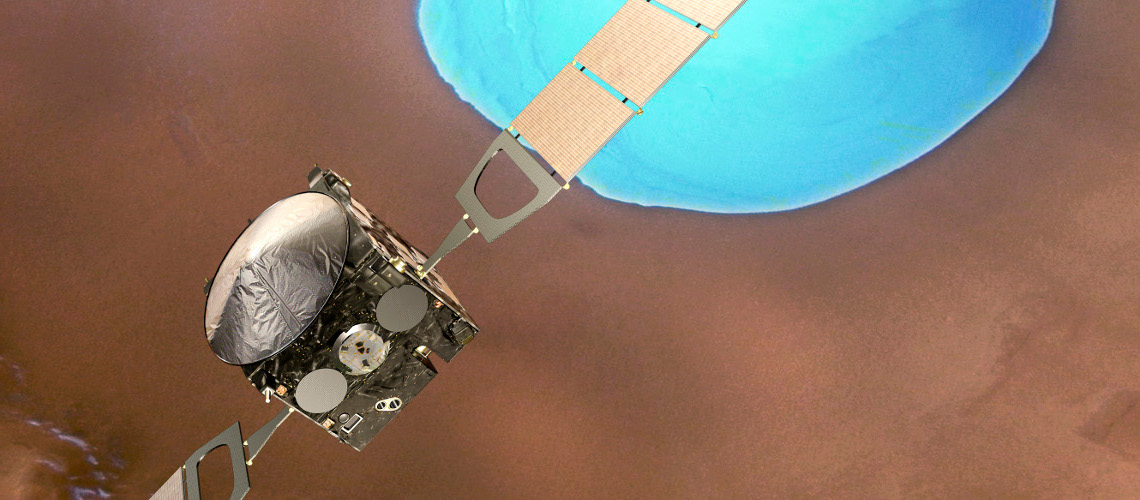Timeline
April 1, 2016, midnight UTC
Aug. 1, 2016, midnight UTC
Data
The data for this competition can be downloaded as a compressed zip file.
Download from Zenodo (Data updated April 6, 2016, 17:35)
The Advanced Mission Concepts' Data Analytics Team from ESOC has prepared the data with care. If you have any questions after reading this description please feel free to post on the competition's discussion page.
Solar aspect angles during a few Martian orbits
Description

The training set (train_set/) is composed of context and electric current measurements data for the following three Martian years:
- Year 1: 2008-08-22 to 2010-07-10
- Year 2: 2010-07-10 to 2012-05-27
- Year 3: 2012-05-27 to 2014-04-14
The test set (test_set/) is composed of context data only for the following fourth Martian year:
- Year 4: 2014-04-14 to 2016-03-01
A Martian year is defined by 687 earth days. Note that space communication issues may have introduced gaps in the given data.
Context data
Context files are all in CSV format and are using the following nomenclature:
- context--YYYY-MM-DD__YYYY-MM-DD--TYPE.csv
- YYYY-MM-DD__YYYY-MM-DD indicates the equivalent of a Martian year period (start and end earth dates).
- TYPE: there are 4 types of context files:
- SAAF: Solar Aspect Angles
- DMOP: Detailed Mission Operations Plan
- FTL: Flight dynamics TimeLine with spacecraft pointing events
- EVTF: Other events
- LTDATA: long term data such as the sun-mars distance
The following list describes the columns of each of these CSV file types:
-
SAAF files: Solar aspect angles are expressed with respect to the Sun-MarsExpress line.
- ut_ms: unix timestamp in milliseconds
- sa: solar aspect angle, angle of Mars Express solar panels' normal
- sx: solar angle of the X axis of satellite
- sy: solar angle of the Y axis of satellite
- sz: solar angle of the Z axis of satellite
The angles are a good information about how much power from the solar panels the spacecraft is going to get (sa) and how much each of its faces is roasting to the sun or freezing in its own shadow (sx, sy, sz).
-
DMOP files: Detailed Mission Operations Plan files.
- ut_ms: unix timestamp in milliseconds
- subsystem: name of the operated subsystem command
The DMOP files show when the different subsystems' commands have been triggered. Each subsystem command string include the subsystem name along with the command name. Each subsystem command name can be considered as a signature. Due to the amount of different commands, they won't be explained here. These commands have different effects on temperatures of the different subsystems of the spacecraft thus impacting in different ways the thermal subsystem's reactions. In these commands you may find the ON/OFF of radio communications, the ON/OFF of the science instruments, etc.
-
FTL files: listing of spacecraft pointing events (Flight Dynamics TimeLine).
- utb_ms: unix timestamp in milliseconds of the time the pointing period begins
- utb_ms: unix timestamp in milliseconds of the time the same pointing period ends
- type: type of pointing or action
- flagcomms: TRUE if any communication device was used, else FALSE.
The events listed here are pointing and action commands that can impact the attitude of the satellite, thus they also may impact the solar aspect angles of the orbiter and/or the switch ON/OFF of some instrumentation.
-
EVTF files: more events are listed in these event files.
- ut_ms: unix timestamp in milliseconds
- description: short description of the event
This file contains a lot of events. It covers parts of the flight dynamics timeline present in the FTL and complements information with a lot of other events. In this file you can find the following eclipse events;
*_PENUMBRA_START,*_PENUMBRA_END,*_UMBRA_START,*_UMBRA_ENDwhich indicates the start and end time of different phases of the eclipse (penumbra/umbra) as you can see in the figure below.
Some of the descriptions are self explanatory while others are not. Due to the amount of different events, they won't be explained here. Nevertheless, the descriptions can be used as signatures of events, similar to the subsystem commands in the DMOP files.
-
LTDATA files: long term data including sun-mars distance and solar constant on Mars.
- ut_ms: unix timestamp in milliseconds, this data provides one sample per day
- sunmars_km: the distance in kilometers between the Sun and Mars
- earthmars_km: the distance in kilometers between the Earth and Mars
- sunmarsearthangle_deg: Sun-Mars-Earth angle in degrees
- solarconstantmars: solar constant at Mars in W/m2W/m2
- eclipseduration_min: total durations of all eclipses in the day, in minutes
- occultationduration_min: total durations of all occultations in the day, in minutes
Observation data
Observation files are also in CSV format and follow the nomenclature:
- power--YYYY-MM-DD__YYYY-MM-DD.csv
- YYYY-MM-DD__YYYY-MM-DD indicates the equivalent of a Martian year period (start and end earth dates).
These files are present only in the training set (train_set/) as they contain the measured electric current of 33 thermal power lines. Each file contains 34 columns:
- ut_ms: unix timestamp in milliseconds
- NPWD----: 33 columns/parameters with the electric current measurements
Usually one observation is made every 30 seconds or 60 seconds. The goal of the competition is to predict the average electric current per hour.
